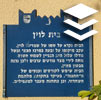The sign shape is rectangular but its head is designed according to the silhouette of the old building of the Gymnasia Herzliya, which serves as a logo of the Council for the Preservation of Heritage Sites in Israel
Beit Ha’am was photographed that day
 Click for a larger image
Click for a larger image The QR code points to the site
Beit Ha’am Translation of the text on the sign:
Symbol of the Council for the Preservation of Israeli Heritage Sites
Emblem of Moshav Herut
The emblem of the Ministry of Culture and Sport
The emblem of the Government Tourism Company
"Tourism Revolution Logo"
Beit Ha’am In an exciting ceremony, in 1955, the cornerstone was laid for the Beit Ha’am building. During the ceremony, the foundation scroll of the settlement was signed and buried among the foundations of the building.
The building was designed by the architects Ilya Belzitzman and Andre Leitersdorf, and the construction work was entrusted to Solel Boneh. The People’s House was designed as a symmetrical and modest structure, and has a central hall and two rows of columns on its sides.
With the completion of construction and the inauguration of the building, in 1959, the Beit Ha’am Hall began to be used for the cultural events of the moshav: movies, holidays, parties, performances, folk dances, family celebrations and a joint Seder night.
Before the current location of Beit Ha’am was determined, the moshav’s cultural center migrated from place to place: from the commune hut to the youth clubs to the blending warehouse, which was used for film screenings and events of the moshav. The establishment of the People’s House made it possible to concentrate all the cultural activities of the moshav in a permanent, spacious and handsome place.
QR code

 Click for a larger image
Click for a larger image  Click for all signs belonging to Heritage Sites in Israel
Click for all signs belonging to Heritage Sites in Israel
 91 Meter |
91 Meter |  106 Meter |
106 Meter |  186 Meter |
186 Meter |  238 Meter |
238 Meter |  241 Meter
241 Meter